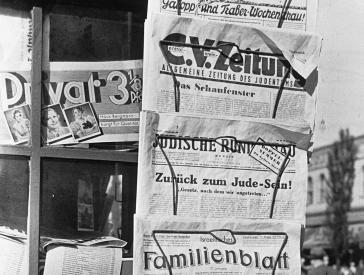"On Trial: Auschwitz / Majdanek" Opening of the new chapter in the permanent exhibition on 27 June
Press Information
Press Release, Thu 27 Jun 2013
The public debate concerning the murder of the European Jews began in a courtroom. "On Trial: Auschwitz / Majdanek", the new chapter in the segment "Present" of the permanent exhibition is dedicated to the two biggest Nazi trials held in West Germany.
- Kontakt
-
Press office
T +49 (0)30 259 93 419
presse@jmberlin.de
- Address
Jewish Museum Berlin Foundation
Lindenstraße 9–14
10969 Berlin
The Frankfurt Auschwitz Trial (1963–1965) and news coverage of the case had a considerable influence on the way the Holocaust was perceived and dealt with in West Germany. The accounts of concentration camp survivors were shocking both to those present in the overflowing courtroom and to the wider international public.
The Düsseldorf Majdanek Trial (1975 – 1981) was the longest and most costly trial in German history. It resulted in acquittals and mild sentences. In view of the mass murders that had been committed, the inadequacy of the court rulings was strikingly obvious.
The Düsseldorf Majdanek Trial (1975 – 1981)
20 years after the beginning of the trial, the painter Minka Hauschild created her series of paintings titled "Majdanek Trial Portraits". She was inspired to create these works by "The Trial" (1984), a documentary film by Eberhard Fechner in which various people involved with the trial were interviewed. The artist took photos of the subjects from her TV screen and, from these still images, painted 44 large format portraits in oil. The series was completed in 1996, and for the fist time it can now be viewed in its complete form at the Jewish Museum Berlin. In the exhibit room, iPads can be used by visitors to learn more about the accused, witnesses, judges and observers in the trial. Accompanying texts provide background stories on the subjects and explain their respective roles in the case. Minka Hauschild's paintings have been hung opposite the black wall of one of the building's "voids" – thus integrating the new exhibition area into Daniel Libeskind's architectural concept.
The Frankfurt Auschwitz Trial (1963 – 1965)
By means of a media installation consisting of three black glass cubes, the museum presents historical television reports on the Auschwitz Trial from West Germany, the Netherlands, and Canada. During 32 minutes of footage, diverse contemporary witnesses are interviewed: the initiator of the trials Fritz Bauer, the State Prosecutor Joachim Kügler, trial observers including Hannah Arendt, the FAZ journalist Bernd Naumann, an Auschwitz survivor, and several members of the public. An alternating sequence of text and film footage gives the viewer an insight into the attitudes, questions and conflicts that were dealt with in the courtroom and in the public sphere at the time.
The historical significance of the Nazi trials
Since 1945, over 36,000 criminal cases involving Nazis have been carried out in Germany. In total, around 6000 sentences were passed relating to Nazi crimes. Of these, 600 resulted in convictions for crimes committed in concentration camps and other places of internment. The majority of the cases did not even go to trial, and were instead often abandoned due to a lack of evidence. Nonetheless, in the course of the investigations related to the cases, the things that took place inside the camps were researched and documented for the first time.
The "Present" chapter in the permanent exhibition
The final part of the permanent exhibition, titled "Present", is dedicated to the history of the Jews in Germany from 1945 to the present day. Adjacent to the new exhibition area "On Trial: Auschwitz / Majdanek" visitors will find the chapter titled "It was as simple as that", which deals with Jewish childhood and youth in Germany, Austria and Switzerland after 1945. "What was it like growing up as a Jew after 1945?" 18 well-known and unknown storytellers have chosen a photo that represents a key experience in their childhood or youth. The accompanying stories are narrated by the protagonists themselves and are located at the end of the historical permanent exhibition titled "Two millennia of German-Jewish history" at the Jewish Museum Berlin.
The exhibition design
The new exhibition area was designed by Holzer Kobler Architekturen Berlin GmbH. The minimal, concise design of the exhibition subtly emphasizes the presented works and content within the setting of Daniel Libeskind's architecture. The conception and realization of the Auschwitz Trial video installation was undertaken by Bernd Hopfengärtner and Frédéric Eyl from TheGreenEyl studios, Berlin.




